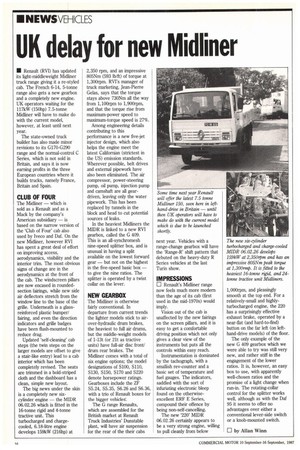UK delay for new idliner
Page 18

If you've noticed an error in this article please click here to report it so we can fix it.
• Renault (RVI) has updated its light-middleweight Midliner truck range giving it a re-styled cab. The French 6-14, 5-tonne range also gets a new gearbox and a completely new engine. UK operators waiting for the 117kW (150hp) 7.5-tonne Midliner will have to make do with the current model, however, at least until next year.
The state-owned truck builder has also made minor revisions to its G170-G290 range and the normal-control C Series, which is not sold in Britain, and says it is now earning profits in the three European countries where it builds trucks, namely France, Britain and Spain.
The Midliner — which is sold as a Renault and as a Mack by the company's American subsidiary — is based on the narrow version of the `Club of Four' cab also used by Iveco and Daf. On the new Midliner, however RVI has spent a great deal of effort on improving access, aerodynamics, visibility and the interior trim. The most obvious signs of change are in the aerodynamics at the front of the cab. The windscreen pillars are now encased in roundedsection fairings, while new side air deflectors stretch from the window line to the base of the grille. Underneath is a glassreinforced plastic bumper/ fairing, and even the direction indicators and grille badges have been flush-mounted to reduce drag.
Updated 'self-cleaning' cab steps (the twin steps on the larger models are offset to give a stair-like entry) lead to a cab interior which has been completely revised. The seats are trimmed in a bold-striped cloth and the dashboard has a clean, simple new layout.
The big news under the skin is a completely new sixcylinder engine — the MIDR 06.02.26 which is fitted in the 16-tonne rigid and 4-tonne tractive unit. This turbocharged and chargecooled, 6.18-litre engine develops 159kW (216hp) at 2,350 rpm, and an impressive 805Nm (593 lb/ft) of torque at 1,300rpm. RVI's manager of truck marketing, Jean-Pierre Gelas, says that the torque stays above 730Nm all the way from 1,100rpm to 1,900rpm, and that the torque rise from maximum-power speed to maximum-torque speed is 27%.
Among engineering details contributing to this performance is a new five-jet injector design, which also helps the engine meet the latest Californian (strictest in the US) emission standards. Wherever possible, belt drives and external pipework have also been eliminated. The air compressor, power-steering pump, oil pump, injection pump and camshaft are all geardriven, leaving only the water pipework. This has been replaced by tunnels in the block and head to cut potential sources of leaks.
In the heaviest Midliners the MIDR is linked to a new RVI gearbox, called the G 409. This is an all-synchromesh nine-speed splitter box, and is unusual in having a split available on the lowest forward gear — but not on the highest in the five-speed basic box — to give the nine ratios. The splitter is operated by a twist collar on the lever.
The Midliner is otherwise fairly conventional. In departure from current trends the lighter models stick to airover-hydraulic drum brakes, the heaviest to full air drums, but the middle-weight models of 1-13t (or 21t as tractive units) have full-air disc front/ drum rear brakes. The Midliner comes with a total of six engine options; the model designations of S100, S110, S130, S150, S170 and S220 denote horsepower ratings. Gearboxes include the ZF S5.24, S5.35, S6.26 and S6.36, with a trio of Renault boxes for the bigger vehicles: The G range Renaults, which are assembled for the British market at Renault Truck Industries' Dunstable plant, will have air suspension for the rear of the their cabs Some time next year Renault will offer the latest 7.5 tonne Midliner 150, seen here in lefthand-drive in Britain — until then UK operators will have to make do with the current model which is due to be launched shortly.
next year. Vehicles with a range-change gearbox will have the `Range-R' shift pattern that debuted on the heavy-duty R Series vehicles at the last Turin show.
El Renault's Midliner range now feels much more modern than the age of its cab (first used in the mid-1970s) would imply.
Vision out of the cab is unaffected by the new fairings on the screen pillars, and it is easy to get a comfortable driving position which not only gives a clear view of the instruments but puts all the controls within easy reach.
Instrumentation is dominated by the tachograph, with a smallish rev-counter and a basic set of temperature and fuel gauges. The indicators, saddled with the sort of infuriating electronic bleep found on the otherwiseexcellent ERF E Series, compound their offence by being non-self-cancelling.
The new '220' MIDR 06.02.26 certainly appears to be a very strong engine, willing to pull cleanly from below turbocharged and charge-cooled MIDR 06.02.26 develops 159kW at 2,3504m and has an impressive 805Nm peak torque at 1,300rmP. It is fitted to the heaviest 16-tonne rigid, and 24tonne tractive unit Midliners.
1,000rpm, and pleasingly smooth at the top end. For a relatively-small and highlyturbocharged engine, the 220 has a surprisingly effective exhaust brake, operated by a near-flat (and hard-to-find) button on the far left (on lefthand-drive models) of the floor.
The only example of the new G 409 gearbox which we were able to try was still very new, and rather stiff in the engagement of the lower ratios. It is, however, an easy box to use, with apparently well-chosen ratios and the promise of a light change when run-in. The rotating-collar control for the splitter works well, although as with the Daf 95 it seems to offer no advantages over either a conventional lever-side switch or a knob-mounted switch.












































































































